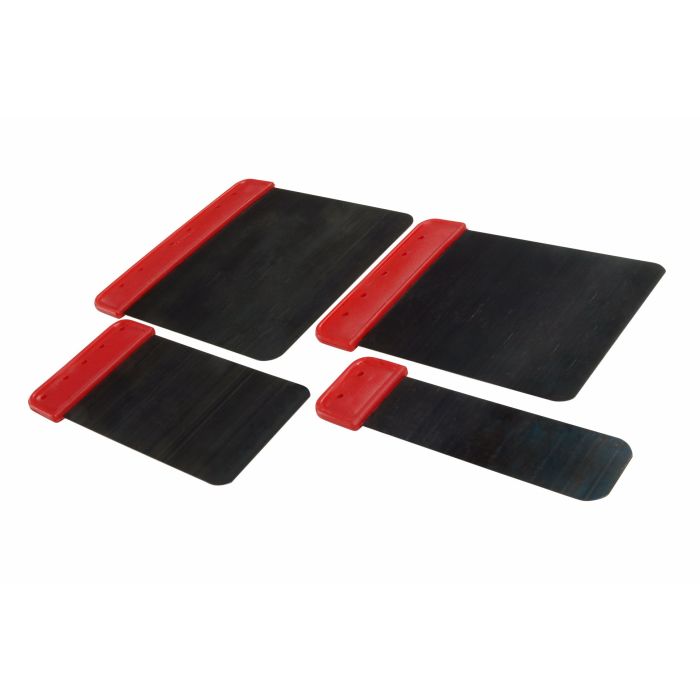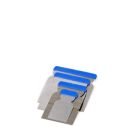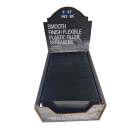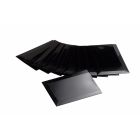|
Why use Sprung steel body filler applicators. Set of 4 different sizes. 25, 50, 75 &100mm
|
|
|
|
A set of sprung steel body filler applicators provides precision, flexibility, and control when applying body fillers, putties, and finishing compounds during vehicle repair and surface restoration.
|
|
|
|
Sprung steel refers to the applicators being made from thin, flexible, high-tensile steel, allowing them to bend slightly under pressure. This flex helps the applicator smooth the filler evenly, follow curves and contours accurately, and minimize air pockets or ridges in the material.
|
|
|
|
Having a set with four different sizes — 25mm, 50mm, 75mm, and 100mm — ensures you have the right width for every task:
|
|
|
|
25mm: Ideal for fine detail work, tight spaces, or small dings and scratches.
|
|
|
|
50mm: Great for medium spot repairs or minor dents.
|
|
|
|
75mm: Suitable for larger surface areas, such as blending repairs on panels.
|
|
|
|
100mm: Best for broad smoothing over large panels like doors, hoods, or quarter panels.
|
|
|
|
The variation in sizes improves both efficiency and finish quality, enabling the user to apply filler precisely where needed with minimal sanding afterward.
|
|
|
|
Additionally, sprung steel applicators are easy to clean, durable, and reusable, making them a reliable tool for professional body shops and serious DIY restorers alike.
|
|
|
|
|
|
The benefits of using a Sprung steel body filler applicators. Set of 4 different sizes. 25, 50, 75 &100mm
|
|
|
|
1. Greater Flexibility and Control
|
|
|
|
The sprung steel blades flex slightly during use, allowing smooth, even application of filler across flat, contoured, or curved surfaces.
|
|
|
|
2. Professional-Quality Finish
|
|
|
|
The flexible steel helps minimize air pockets, ridges, and drag marks, resulting in smoother filler layers that require less sanding and rework.
|
|
|
|
3. Versatility for Different Repair Sizes
|
|
|
|
The set includes four different widths:
|
|
|
|
|
|
|
|
25mm: Perfect for small chips, fine scratches, and detailed repairs.
|
|
|
|
50mm: Ideal for medium dents and spot filling.
|
|
|
|
75mm: Suited for blending larger repair areas smoothly.
|
|
|
|
100mm: Great for spreading filler across large panels like hoods and doors.
|
|
|
|
4. Increased Efficiency
|
|
|
|
Having multiple sizes available allows you to choose the right applicator for the job, speeding up filler application and improving workflow.
|
|
|
|
5. Durable and Reusable
|
|
|
|
Made from high-tensile sprung steel, these applicators are robust, long-lasting, and easy to clean after use, making them a cost-effective investment.
|
|
|
|
6. Better Access to Tight Areas
|
|
|
|
The smaller-sized applicators (25mm and 50mm) make it easy to apply filler neatly in tight spaces, edges, seams, and around body contours.
|
|
|
|
7. Lightweight and Easy to Handle
|
|
|
|
The thin, lightweight design provides excellent user control, reducing fatigue during prolonged bodywork sessions.
|
|
|
|
8. Suitable for a Range of Materials
|
|
|
|
Ideal for use with body fillers, glazing putty, fiberglass resin, and fine finishing compounds, making them a versatile tool in any repair kit.
|
|
|
|
|
|
|
|
|
|
Uses and applications of a Sprung steel body filler applicators. Set of 4 different sizes. 25, 50, 75 &100mm
|
|
|
|
1. Automotive Body Repair
|
|
|
|
Use: Applying body filler to repair dents, dings, scratches, and panel imperfections.
|
|
|
|
Application: Collision repair centers, custom car builders, automotive restoration shops.
|
|
|
|
2. Spot Repairs and Fine Detailing
|
|
|
|
Use: Using smaller applicators (25mm and 50mm) to fill fine scratches, pinholes, door edge chips, and minor imperfections.
|
|
|
|
Application: SMART repair specialists, mobile bodywork services, detailing shops.
|
|
|
|
3. Large Area Surface Smoothing
|
|
|
|
Use: Using larger applicators (75mm and 100mm) to spread filler evenly across bigger sections like hoods, doors, roofs, and fenders.
|
|
|
|
Application: Panel beating, full vehicle resprays, vehicle restorations.
|
|
|
|
4. Blending and Feathering Repairs
|
|
|
|
Use: Feathering edges of filled areas smoothly into existing paint or primer layers to minimize sanding work later.
|
|
|
|
Application: Bodyshop finishing, refinishing and repainting processes.
|
|
|
|
5. Fiberglass and Composite Repair
|
|
|
|
Use: Applying resin or filler to fiberglass panels, body kits, and composite parts for structural or cosmetic repairs.
|
|
|
|
Application: Marine repairs, motorcycle fairings, RV and caravan restoration.
|
|
|
|
6. Home and DIY Projects
|
|
|
|
Use: Filling and smoothing surfaces on furniture, garden equipment, and other DIY repair tasks where precision filler work is needed.
|
|
|
|
Application: Home workshops, DIY enthusiasts, hobby car restorers.
|
|
|
|
7. Industrial Equipment Maintenance
|
|
|
|
Use: Surface preparation and cosmetic repair of industrial metal parts, machinery panels, and enclosures.
|
|
|
|
Application: Industrial maintenance teams, fabrication and refurbishment services.
|







